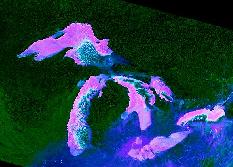 The first ever report on sewage contamination in the Great Lakes ecosystem has revealed poor water treatment standards and the widespread dumping of raw sewage by our cities.
The first ever report on sewage contamination in the Great Lakes ecosystem has revealed poor water treatment standards and the widespread dumping of raw sewage by our cities.
In total, 93 billion litres of raw sewage are entering the lakes each year, posing an environmental risk and a threat to the primary drinking water source for millions of people on both sides of the Canada - US border.
The report, titled The Great Lakes Sewage Report Card, was released by Sierra Legal and evaluates the sewage treatment standards of 20 municipalities from both Canada and the United States. Green Bay, Peel Region and Duluth ranked the highest among all cities while Detroit, Cleveland and Windsor received the report's worst grades due mostly to their reliance on combined sewers - a system that carries both rainwater and sewage in one pipe and can easily become overloaded in heavy rain storms. Buffalo, Durham-York, Kitchener-Waterloo, Toledo and East Chicago did not respond to requests for information and were not included in the analysis.
The report called foir improved treatment standards while making the following general recommendations:
- Water Conservation: Increased water conservation for households could immediately reduce water use by more than 40% and dramatically reduce the demand for water treatment.
- Rain Water Diversion: Disconnect residential downspouts and footing drains, and use rain barrels and porous landscaping materials to reduce the volume of storm water entering municipal systems in the first place.
- Separate Combined Sewage Systems: in order to stop sewage overflows during heavy rains.
- Stop Chemicals Pollution: Preventing toxic chemicals from entering the sewage system in the first place would significantly reduce the burden of sewage effluent and sludge.
- Fund Infrastructure and Research
Despite decades of international conservation work to protect the lakes, the report did not find a single municipality with what it considered a fully up-to-date wastewater treatment system.
A better commitment is clearly needed.
The Great Lakes contain 20% of all the fresh water in the world, but they replenish at a rate of just 1% per year. This means that the sewage we are dumping today will be with us for the next century.
Read the complete report here.
See all grades here.